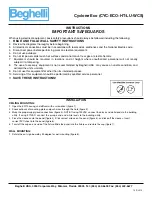
Form #: SDS 853027
Revised:
05/14/15
Supersedes: NEW
ECO #:
1001584
SAFETY DATA SHEET
Acute Toxicity:
Inhalation LD50:
Electrolyte: LC50 rat: 375 mg/m3; LC50: guinea pig: 510 mg/m3
Elemental Lead: Acute Toxicity Point Estimate = 4500 ppmV (based on lead bullion)
Oral LD50:
Electrolyte: rat: 2140 mg/kg
Elemental lead: Acute Toxicity Estimate (ATE) = 500 mg/kg body weight (based on lead bullion)
Additional Health Data:
All heavy metals, including the hazardous ingredients in this product, are taken into the body primarily by inhalation and ingestion.
Most inhalation problems can be avoided by adequate precautions such as ventilation and respiratory protection covered in Section 8.
Follow good personal hygiene to avoid inhalation and ingestion: wash hands, face, neck and arms thoroughly before eating, smoking or leaving the
worksite. Keep contaminated clothing out of non-contaminated areas, or wear cover clothing when in such areas. Restrict the use and presence of food,
tobacco and cosmetics to non-contaminated areas. Work clothes and work equipment used in contaminated areas must remain in designated areas and
never taken home or laundered with personal non-contaminated clothing. This product is intended for industrial use only and should be isolated from
children and their environment.
The 19
th
Amendment to EC Directive 67/548/EEC classified lead compounds, but not lead in metal form, as possibly toxic to reproduction.
Risk phrase 61: May cause harm to the unborn child, applies to lead compounds, especially soluble forms.
XII. ECOLOGICAL INFORMATION
Environmental Fate:
Lead is very persistent in soil and sediments. No data on environmental degradation. Mobility of metallic lead between ecological compartments is slow.
Bioaccumulation of lead occurs in aquatic and terrestrial animals and plants but little bioaccumulation occurs through the food chain.
Most studies include lead compounds and not elemental lead.
Environmental Toxicity:
Aquatic Toxicity:
Sulfuric acid:
24-hr LC50, freshwater fish (Brachydanio rerio): 82 mg/L
96 hr- LOEC, freshwater fish (Cyprinus carpio): 22 mg/L
Lead:
48 hr LC50 (modeled for aquatic invertebrates): <1 mg/L, based on lead bullion
Additional Information:
· No known effects on stratospheric ozone depletion.
· Volatile organic compounds: 0% (by Volume)
· Water Endangering Class (WGK): NA
XIII. DISPOSAL CONSIDERATIONS (UNITED STATES)
Spent batteries: Send to secondary lead smelter for recycling. Spent lead-acid batteries are not regulated as hazardous waste when the requirements of
40 CFR Section 266.80 are met. This should be managed in accordance with approved local, state and federal requirements. Consult state environmental
agency and/or federal EPA.
Electrolyte:
Place neutralized slurry into sealed containers and handle as applicable with state and federal regulations. Large water-diluted spills, after
neutralization and testing, should be managed in accordance with approved local, state and federal requirements. Consult state environmental
agency and/or federal EPA.
Following local, State/Provincial, and Federal/National regulations applicable to end-of-life characteristics will be the responsibility of the end-user.
Page 5
All manuals and user guides at all-guides.com






































